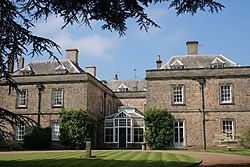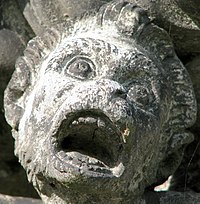Melbourne Hall: Difference between revisions
Created page with "{{Infobox building |county=Derby |picture=Melbourne_Hall.jpg |picture caption=Melbourne Hall main entrance |name=Melbourne Hall |town=Melbourne |clie..." |
m →top: ioe -> nhle, replaced: {{IoE|83043 → {{NHLE|1204079 |
||
| Line 12: | Line 12: | ||
|type=Country house | |type=Country house | ||
}} | }} | ||
'''Melbourne Hall''' in [[Derbyshire]] was once the seat of the Victorian Prime Minister William Lamb, 2nd Viscount Melbourne, and thus is the origin of the name of the city of Melbourne in Australia. The house is now the seat of Lord and Lady Ralph Kerr and is open to the public.<ref>{{cite web|title=Melbourne Hall and Gardens|url=http://www.visitderbyshire.co.uk/details-1495.ihtml|publisher=Visit Derbyshire}}</ref> The house is a Grade II* listed building;<ref>{{ | '''Melbourne Hall''' in [[Derbyshire]] was once the seat of the Victorian Prime Minister William Lamb, 2nd Viscount Melbourne, and thus is the origin of the name of the city of Melbourne in Australia. The house is now the seat of Lord and Lady Ralph Kerr and is open to the public.<ref>{{cite web|title=Melbourne Hall and Gardens|url=http://www.visitderbyshire.co.uk/details-1495.ihtml|publisher=Visit Derbyshire}}</ref> The house is a Grade II* listed building;<ref>{{NHLE|1204079|accessdate=21 April 2015}}</ref> more than twenty features in the grounds are Grade I listed. | ||
Melbourne, a manor that had belonged to the [[bishop of Carlisle|bishops of Carlisle]] in the twelfth century, was partly rebuilt in 1629–31 for Sir John Coke by a Derbyshire mason, Richard Shepherd.<ref name="Colvin">Colvin</ref> In 1692 it was inherited by Thomas Coke (1675–1727), a gentleman architect in the golden age of English amateur architecture, who laid out the formal gardens that survive, with some professional assistance from Henry Wise, between about 1696 and 1706: there are avenues, a parterre, a yew walk that has become a yew tunnel, basins and fountains, and lead and stone sculpture, much of it supplied by John Nost. Coke travelled in the Netherlands and he turned to Nost, the famous statuary born in the Austrian Netherlands, with premises in Haymarket, London, who provided lead figures of amorini, vases, baskets of flowers and mythological figures, still identifiable at Melbourne, and most notably the lead "Vase of the Seasons" (1705), that is one of the finest examples of Baroque sculpture in lead in an English garden.<ref name="Gunnis">Gunnis</ref> Nost also provided a number of chimneypieces in the house as well as for Sir Thomas's London house in St. James's Place, one of which came to £50. At the sale of Nost's effects, Sir Thomas purchased his copy of Serlio's ''Five Books of Architecture, English'd by Robert Peake'', which is still in the Library. | Melbourne, a manor that had belonged to the [[bishop of Carlisle|bishops of Carlisle]] in the twelfth century, was partly rebuilt in 1629–31 for Sir John Coke by a Derbyshire mason, Richard Shepherd.<ref name="Colvin">Colvin</ref> In 1692 it was inherited by Thomas Coke (1675–1727), a gentleman architect in the golden age of English amateur architecture, who laid out the formal gardens that survive, with some professional assistance from Henry Wise, between about 1696 and 1706: there are avenues, a parterre, a yew walk that has become a yew tunnel, basins and fountains, and lead and stone sculpture, much of it supplied by John Nost. Coke travelled in the Netherlands and he turned to Nost, the famous statuary born in the Austrian Netherlands, with premises in Haymarket, London, who provided lead figures of amorini, vases, baskets of flowers and mythological figures, still identifiable at Melbourne, and most notably the lead "Vase of the Seasons" (1705), that is one of the finest examples of Baroque sculpture in lead in an English garden.<ref name="Gunnis">Gunnis</ref> Nost also provided a number of chimneypieces in the house as well as for Sir Thomas's London house in St. James's Place, one of which came to £50. At the sale of Nost's effects, Sir Thomas purchased his copy of Serlio's ''Five Books of Architecture, English'd by Robert Peake'', which is still in the Library. | ||
Latest revision as of 08:30, 19 September 2019
| Melbourne Hall | |
|
Derbyshire | |
|---|---|
 Melbourne Hall main entrance | |
| Type: | Country house |
| Location | |
| Location: | 52°49’13"N, 1°25’27"W |
| Town: | Melbourne |
| History | |
| Built 12th century | |
| For: | Sir John Coke |
| Country house | |
| Information | |
Melbourne Hall in Derbyshire was once the seat of the Victorian Prime Minister William Lamb, 2nd Viscount Melbourne, and thus is the origin of the name of the city of Melbourne in Australia. The house is now the seat of Lord and Lady Ralph Kerr and is open to the public.[1] The house is a Grade II* listed building;[2] more than twenty features in the grounds are Grade I listed.
Melbourne, a manor that had belonged to the bishops of Carlisle in the twelfth century, was partly rebuilt in 1629–31 for Sir John Coke by a Derbyshire mason, Richard Shepherd.[3] In 1692 it was inherited by Thomas Coke (1675–1727), a gentleman architect in the golden age of English amateur architecture, who laid out the formal gardens that survive, with some professional assistance from Henry Wise, between about 1696 and 1706: there are avenues, a parterre, a yew walk that has become a yew tunnel, basins and fountains, and lead and stone sculpture, much of it supplied by John Nost. Coke travelled in the Netherlands and he turned to Nost, the famous statuary born in the Austrian Netherlands, with premises in Haymarket, London, who provided lead figures of amorini, vases, baskets of flowers and mythological figures, still identifiable at Melbourne, and most notably the lead "Vase of the Seasons" (1705), that is one of the finest examples of Baroque sculpture in lead in an English garden.[4] Nost also provided a number of chimneypieces in the house as well as for Sir Thomas's London house in St. James's Place, one of which came to £50. At the sale of Nost's effects, Sir Thomas purchased his copy of Serlio's Five Books of Architecture, English'd by Robert Peake, which is still in the Library.

Among fine wrought iron made for the grounds at Melbourne by Robert Bakewell is the wrought-iron arbour known as the "birdcage".
Though he drew up a plan for remodelling the sixteenth and seventeenth-century house and had the west wing rebuilt by Francis Smith of Warwick it remained to his son, G. L. Coke to rebuild the east front, facing the garden, and adjust the south front, in 1743–44, to a design by William Smith, the son of Francis Smith.[5] His design for a gatehouse, built "according to his Honour's Draught" was built by Smith of Warwick but dismantled before the end of the eighteenth century. Unidentified alterations undertaken in 1720–21 were carried out by the builder William Gilks of Burton-on-Trent. The figure of George Lewis Coke remains an ambiguous one. Some believe that he was never at Melbourne after he left for a foreign tour in his late teens.
Redecorations of the interior were carried out throughout the century, in several campaigns. In 1745 Joseph Hall of Derby was paid for the chimneypiece in the Great Dining Room;[4] in the 1760s, stucco by Samuel Franceys was executed, and for the First Viscount Melbourne, in 1772, further interior alterations were carried out by the leading Derbyshire architect, Joseph Pickford.[3] The second Lord Melbourne, Queen Victoria's Prime Minister, was separated from his wife, Lady Caroline Lamb, in 1825, when her liaison with Lord Byron had become notorious.
The house passed into the hands of the Cowper family when Emily Lamb, sister of the childless third and last Viscount Melbourne, married the 5th Earl Cowper. (She later married another Prime Minister, Lord Palmerston.) It remained in the Cowper family until Lady Amabel Cowper married Admiral of the Fleet Lord Walter Kerr who made Melbourne the family home in 1906.
The current owner Lord Ralph Kerr also owns Ferniehirst Castle in Roxburghshire. He is the heir to the Marquessate of Lothian as his brother the 13th Marquess, better known as the politician Michael Ancram, has no sons, though he has two daughters.
Notes
- ↑ "Melbourne Hall and Gardens". Visit Derbyshire. http://www.visitderbyshire.co.uk/details-1495.ihtml.
- ↑ National Heritage List 1204079: Melbourne Hall
- ↑ 3.0 3.1 Colvin
- ↑ 4.0 4.1 Gunnis
- ↑ William Jackson, of Melton Mowbray, was the master mason, paid £1500 (Gunnis).
References
- Howard Colvin, A Biographical Dictionary of British Architects, 1600–1840, 3rd ed. 1995: "Thomas Coke", William Gilks"
- David Green, Gardener to Queen Anne, 1956. (Henry Wise)
- Rupert Gunnis, Dictionary of British Sculptors 1660–1851, rev, ed.
- Christopher Hussey, English Gardens and Landscapes 1700–1750.
Outside links
| ("Wikimedia Commons" has material about Melbourne Hall) |
- Melbourne Hall and Gardens—official site
